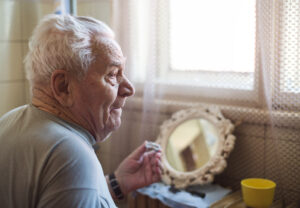Home » People and Settings » Aging
Aging
Overview of Aging
Stories Across the Lifespan
The following stories describe how older adults who are aging can access positive supports.
- Assertive Community Treatment: Jose (MNPSP web page)
- Person-Centered Practices and Aging: Eveleth (MNPSP web page)
- Positive Behavior Support and Aging: Kemal (MNPSP web page)
- Trauma Informed Approaches and Aging: Ruth (MNPSP web page)
- ABA and Older Adults: River Bend Adult Day Program, Edwin (MNPSP web page)

Aging Resources
- Mental Health and Aging in America (pdf)
- Evidence-based Disease Prevention – Center for Healthy Aging (external web page)
- National Alliance for Direct Support Professionals–Aging with Dignity: Direct Support Professionals Supporting Individuals and Families in the Process (pdf)
- Person-Centered Thinking: Improving the Quality of Person-centered Planning (pdf)
- Health Education for the Elderly (pdf)
- DHS Home and Community Based Services (external web page)
- Minnesota Age & Disabilities Annual Conference (external web page)
- Caregiver’s Guide: Information and Resources About Alzheimer’s disease and Other Dementias (pdf)
- Impact: Feature Issue on Aging and People with Intellectual and Developmental Disabilities (external web page)
- Healthy Aging and Disability (external web page)
- Older Americans and Behavioral Health from Substance Abuse and Mental Health Services Administration (SAMHSA) and Administration on Aging (AoA) (external web page)
- Association for Positive Behavior Support (APBS) (external web page)
- Star Tribune Article Describing Person-Centered Practices and Positive Behavior Support (external web page)
- Minnesota Department of Human Services for Seniors (external web page)
- Strengthening Community-Based Services for Asian American and Pacific Islanders Affected by Dementia (pdf)
Positive Support Strategies for Aging
Below are some articles designed to provide important background information about topics that are relevant across lifespans and settings.
- Applied Behavior Analysis in Practice – ABA is focused on better understanding how different variables impact an individual’s behavior.
- Assertive Community Treatment History – A group of mental health professionals reviewed the mental health system to determine strategies to help people remain in their communities.
- Person-Centered Planning and Promoting Quality of Life – One way to think about person-centered practices from a systems perspective is to use a Three-Tiered Model of Positive Supports.
- PBS and Preventing Problem Behavior Using the Three-Tiered System – Considering larger organizational issues can be a helpful way to create a positive climate and prevent challenging behavior.
- Positive Behavior Support and Individualized Planning – The first step in an individualized positive behavior support process at Tier 3 is to set up a person-centered plan.
- Trauma Informed Approaches and Three-Tiered Systems of Positive Support – Trauma informed care approaches are implemented across education and human service organizations.
- Relationship Between Applied Behavior Analysis and Positive Behavior Support – Understand the history and current relationship between Applied Behavior Analysis and Positive Behavior Support


